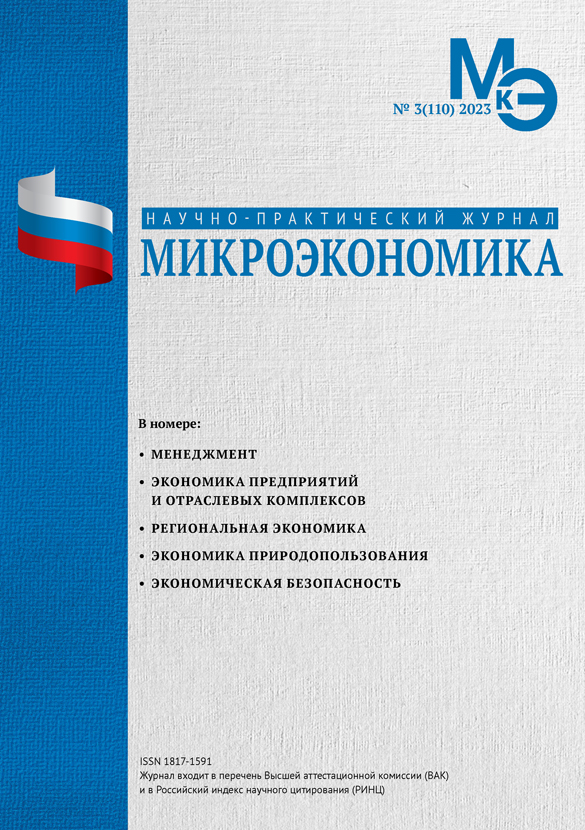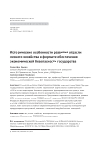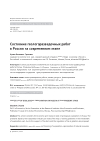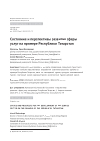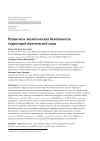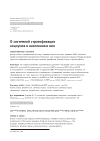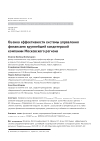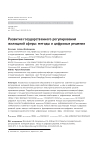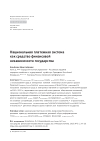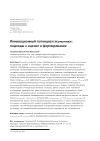Historical features of the development of the forestry industry in the format of ensuring the economic security of the state
DOI: 10.33917/mic-3.110.2023.86-92
The article examines the general historical periods of development and transformation of the structure of public administration in the system of national protection of forestry in Russia from the XVII century to the present. The prerequisites for the formation of forest law are outlined, as well as further improvement of forest legislation, in particular, the process of development of criminal responsibility is analyzed. Modern regulatory legal acts regulating the basics of state management of the forest sector of the Russian Federation are presented. The causal relationship in the commission of criminal acts in forestry is highlighted. Based on the factors generating the growth of criminogenicity in the forest industry, the main directions of the state necessary for the prevention of crimes related to illegal logging of forest plantations were given.
References:
1. Tikhomirov M.N. The Cathedral Code of 1649 / M.N. Tikhomirov, P.P. Epifanov. Moscow: Publishing house of Moscow. un-ta, 1961. 65 p.
2. Votyakova E.S. The history of the development of Criminal legislation on crimes in the sphere of entrepreneurial activity / E. S. Votyakova // Topical issues of legal sciences: materials of the International Scientific Conference (Chelyabinsk, November 2012). Chelyabinsk: Two Komsomol Members, 2012. pp. 77-79. (In Russ.).
3. Criminal Code of 1903 on state crimes. Russian legislation of the X–XX centuries: in 9 volumes / under the general editorship of O.I. Chistyakov. Vol. IX. Moscow, 1994.
4. The Forest Code of the Russian Federation of 04.12.2006 N 200-FZ (ed. of 02.07.2021) (with amendments and additions, intro. effective from 01.09.2021). – Access from the legal reference system Consultant-Plus. URL: http://www.consultant.ru/document/cons_doc_LAW_64299
5. Kiseleva L.V. The history of the development of economic crimes in the field of construction as a growing danger of undermining the economic security of the Russian Federation / L. V. Kiseleva, K. A. Zelenkov // Bulletin of the Nizhny Novgorod Academy of the Ministry of Internal Affairs of Russia. 2010;2 (13):266-268. (In Russ.).
6. Zubkova V.I. The role of criminal punishment in the prevention of crimes // Collection: Criminal correctional law: Materials of the interuniversity scientific and practical conference. Moscow, 2017;12(1):27-30. (In Russ.).
7. Kuzmichev E.P. Volumes of illegal logging of forest plantations in the Russian Federation / Kuzmichev.P., Trushinai.G., Lopatin.V. URL: http://lhi.vniilm.ru /
8. Tolpyshev G.B. Ensuring the economic security of forestry: Monograph / G.V. Tolpyshev, A.G. Svetlakov // M-vo S.-x RF, Perm State Technical University. Perm, 2020. 218 p. (In Russ.).
9. Statistical data of the FKU «GIAC of the Ministry of Internal Affairs of Russia». URL: http://www.mvd.ru
The state of geological exploration in Russia at the present stage
DOI: 10.33917/mic-3.110.2023.80-85
The article considers the economic and resource state of geological exploration in Russia. The problems faced by the exploration industry are noted. The ways of solving problems in the investment of exploration work due to the support of the state and the regulation of tax legislation are proposed.
References:
1. Decree of the Government of the Russian Federation «On approval of the Strategy for the development of the mineral resource base of the Russian Federation until 2035» dated December 22, 2018 No. 2914-r. – Access from the legal reference system «Garant».
2. The future of Russian exploration under sanctions. URL: https://sectormedia.ru/news/neftegazodobycha/budushchee-rossiyskoy-geologorazvedki-v-usloviyakh-sanktsiy/
3. Ministry of Natural Resources and Ecology of the Russian Federation. URL: https://www.mnr.gov.ru
4. The State Program of the Russian Federation «Reproduction and Use of Natural Resources» (as amended by Decree of the Government of the Russian Federation of March 31, 2021 No. 515).
5. Exploration: trends and prospects. URL: http://eage.ru/upload/File/Overview_of_trends_and_prospects_of_geological exploration_WEB.pdf
6. Rosgeo: exploration volumes did not decrease significantly in 2022. URL: https://rg.ru/2022/12/27/rosgeologiia-v-2022-godu-obemy-geologorazvedkisushchestvenno-ne-snizilis.html
7. Rosnedra: Information on the implementation of geological exploration for January-June 2022 – form No. 2-gr. URL: https://nangs.org/analytics/rosnedra-svedeniya-ovypolnenii-geologorazvedochnykh-rabot-za-yanvar-dekabr-2018-goda-forma-2-gr-rar-xls
8. Agafonova A.S., Melekhin E.S. The effectiveness of the results of the subprogram «reproduction of the mineral resource base, geological study of the subsoil». Collection of students’ abstracts «Issues of economics and management of the oil and gas complex». M.: GRU oil and gas them. THEM. Gubkina, 2022, pp. 35-36. (In Russ.).
9. Melekhin E.S. Methodology of tax regulation of the use of hydrocarbon reserves. Problems of economics and management of the oil and gas complex. 2023;1 (217):18-23. (In Russ.).
10. Melekhin E.S., Panfilov E.I. Problems of rational use of the mineral resource base of hydrocarbons in Russia. Problems of economics and management of the oil and gas complex. 2022;6 (210):5-11. (In Russ.).
Status and prospects for the development of the service sector on the example of the Republic of Tatarstan
DOI: 10.33917/mic-3.110.2023.72-79
The scientific article proposes an algorithm for determining the total tourism potential on the example of the most promising areas for the development of domestic tourism on the example of the Republic of Tatarstan: youth tourism; cultural and educational tourism; sports tourism; cruise tourism; ecological tourism; business tourism.
References:
1. Zhukovskaya I.V. Segmentation of the service market: problems, solutions // Microeconomics. 2021;2:32-37. (In Russ.).
2. Regions of Russia. Socio-economic indicators. 2021. Rosstat. URL: http://rosstat.gov.ru
3. Ragimkhanov A.V. Systematization of scientific approaches to the study of the competitiveness of services: from theory to practice / A.V. Ragimkhanov, I.V. Zhukovskaya // Microeconomics. 2022;1:75-78/ (In Russ.).
4. Statistical collection. Information-analytical materials. Methodology. Rosstat. URL: http://rosstat.gov.ru
Arctic zone territories development and their environmental safety
DOI: 10.33917/mic-3.110.2023.59-71
The article is devoted to creating new and improving existing infrastructure in the territories of the Arctic zone of the Russian Federation, ensuring the year-round operation of the Northern Sea Route as a promising international main waterway. The authors analyze the liquefied natural gas production plants, ports, and railways under construction on the coast of the seas of the Arctic Ocean as these objects create opportunities for increasing the volume of maritime transport and icebreakers, as well as the speed of goods delivery to the countries of the Southeast Asia and the Pacific basin. In addition, the facilities optimizing energy supply are studied as key impacts that improve the conditions and quality of life of the population in this area. The authors analyze the fundamental documents for the development of the Arctic zone, approved by the President and the Government of the Russian Federation. The article highlights dynamics of the population, average per capita cash income from 2005 to 2021 as the main factor contributing to the population stability and the main indicators from the annual state statistical reporting, that characterize the changes in the level of atmosphere and surface water pollution and determine the level of environmental safety of the Arctic zone territories of the Russian Federation.
References:
1. On the Fundamentals of the State Policy of the Russian Federation in the Arctic for the period up to 2035: Decree of the President of the Russian Federation of March 5, 2020. No. 164. URL: https://www.garant.ru/products/ipo/prime/doc/73606526/?ysclid=leipxu0360530940135
2. On the strategy for the development of the Arctic zone of the Russian Federation and ensuring national security until 2035: Decree of the President of the Russian Federation of October 26, 2020. No. 645. URL: https://base.garant.ru/74810556/?ysclid=leiptmnf9732603907
3. On the land territories of the Arctic zone of the Russian Federation: Decree of the President of the Russian Federation of May 2, 2014. No. 296 Retrieved from: https://www.garant.ru/products/ipo/prime/doc/70547984/?ysclid=leipqod76a520696147
4. On approval of the plan for the development of the Northern Sea Route for the period up to 2035: Decree of the Government of the Russian Federation of August 1, 2022. No. 2115-r. URL: https://www.garant.ru/products/ipo/prime/doc/405010751/?ysclid=ldj6si8gbn565996760
5. On the peculiarities of providing citizens with land plots that are in state or municipal ownership and located in the Arctic zone of the Russian Federation and in other territories of the North, Siberia and the Far East of the Russian Federation, and on amendments to certain legislative acts of the Russian Federation: Federal Law of 05/01/2016. No. 119-FZ. URL: https://base.garant.ru/71388648/?ysclid=leiq5wwuqg271926707
6. On production and consumption waste: Federal Law No. 89-FZ of June 24, 1998 (as amended on December 19, 2022. URL: https://base.garant.ru/12112084/?ysclid=leiq4enzyz155209384
On the systemic stratification of societies and the population in them
DOI: 10.33917/mic-3.110.2023.50-58
The problem of stratification of societies and the population in them according to the criterion of specific production of national capital (NPC) and capital (PCC) of subjects of the Russian Federation is discussed in comparison with stratification by specific GDP. The integral interpretation of capital as the sum of physical, human and social components means: scientifically substantiated stratification of both the countries of the world and their population is based not on indicators of the standard of living, but on indicators of the quality of life; not from GDP, but from PNK or a dimensionless analogue of PNK – the quality of life index I. Stratification by GDP is another suggestion in science.
References:
1. Ponomarev V. Avant-garde stratification of nations // Economic strategies. 2022;3:16-25. (In Russ.).
2. Golubev V.S. Harmony will save the world. M., LENAND, 2017. 296 p.
3. Bushuev V.V., Golubev V.S., Orlov I.B. Introduction to the system theory of capital. M.: Lenand, 2013. 176 p.
4. Bushuev V.V., Golubev V.S., Tarko A.M. Structural energy as a development potential. World and Russia. M., LENAND, 2014. 157 p.
5. Golubev V.S. Scientific basis of energy strategies // Economic strategies 2022;3:38-53. (In Russ.).
6. Bushuev V.V., Golubev V.S. Man and time in the evolving world. M., LENAND, 2014. 192 p.
7. Golubev V.S. Fundamentals of ecosociohumanism. M.: INFRA-M, 2022. 158 p.
Evaluation of the effectiveness of the financial management system of the largest confectionery company in the commodity market of the Moscow region
DOI: 10.33917/mic-3.110.2023.37-49
An assessment of the financial potential and corporate asset management policy of the leading manufacturing company in the commodity market of the Moscow region – JSC «Bolshevik» was carried out. It is determined that the company is not financially stable. It is recommended to change the current liabilities management policy from aggressive to moderate in order to improve the financial position of the corporation, increase its stability and solvency.
References:
1. Atamanyuk O.Ya., Matushevskaya E.A. Features of property and capital valuation on the example of a confectionery factory. In the collection: Economics and the banking system: theory and practice. Materials of the correspondence international scientific and practical conference. Dagestan State University; North Caucasus Federal University; Financial University under the Government of the Russian Federation. 2016. pp. 54-60.
2. Belchuk E.V., Marien L.S. Industry of Russia: regional features of development at the macro and meso levels. In the collection: Issues of economics and management at the present stage of development. Collection of scientific articles on the results of the All-Russian Conference. Edited by I.E. Belskikh. 2015. pp. 14-17.
3. Documentary history of JSC «Bolshevik». Past, present, future. Gl. ed. by E. Stupakov. Monograph, Publishing House: Newsmakers, Moscow, 2006.
4. Mikoyan L.V. Development of a strategy for the development of a confectionery factory. In the book: Science Week 2020. Collection of abstracts in two parts. Rostov-on-Don, 2020. pp. 214-217.
5. Mikoyan L.V., Orlova V.G. Marketing analysis of confectionery factory products. In the collection: Technologies of marketing, brand management and advertising. Materials of the All-Russian Scientific and practical Conference. State University of Management. Moscow, 2019. pp. 55-57.
6. Mikoyan L.V., Orlova V.G. Strategic analysis of the activity of the confectionery factory. In the collection: Problems of automation. regional management. communication and automation (SAILS-2019). Proceedings of the VIII All-Russian Scientific Conference of Young Scientists, postgraduates and students. Proceedings of the VIII All-Russian Scientific Conference of Young Scientists, Postgraduates and students, In two volumes. 2019. pp. 85-92.
7. Naumova R.E. Features of cost optimization for the production of confectionery factory products. In the collection: Accounting, analysis and audit: current state and prospects of development. materials of the XII International Scientific and Practical Conference. Ural State University of Economics. Yekaterinburg, 2021. pp. 150-152.
8. Naumova R.E. Features of cost analysis at a confectionery factory. In the collection: Actual problems of accounting, analysis and audit. Materials of the XIII All-Russian Youth Scientific and Practical Conference with international participation. Kursk, 2021. pp. 315-319.
9. Penkina Yu.I., Kalinin Yu.S. Development of a program plan for mandatory preliminary events at a confectionery factory. Research and development of young scientists. 2016;15:70-73. (In Russ.).
Development of state regulation of the housing sector: methods and digital solutions
DOI: 10.33917/mic-3.110.2023.29-36
The relevance of the study is due to the need to develop state regulation of the housing sector through the most effective methods and digital solutions aimed at ensuring the availability of housing for the population and improving the living conditions of citizens. The methods of regulation of the housing sector associated with state financial support for certain categories of participants in housing relations are analyzed in detail. In this regard, the need for digitalization of the housing sector and the transformation of production relations and procedures aimed at creating a digital ecosystem was noted. The most significant for the development of methods for regulating the housing sector in the context of digitalization are the State Information System for Housing and Communal Services and the State Services Portal. Based on the analysis of existing methods and digital solutions, we came to the conclusion that it is necessary to form complex digital technologies and smooth out differences in the pace of digitalization of the housing sector in megacities and other cities.
References:
1. Providing citizens with social support for paying for housing and utilities in the constituent entities of the Russian Federation. URL: https://rosstat.gov.ru/statistics/zhilishhnye_usloviya
2. Evaluation of the business activity of housing developers. URL: https://xn--d1aqf.xn--p1ai/analytics/polls/
3. Shared multi-apartment construction in the Russian Federation URL: https://xn--d1aqf.xn--p1ai/analytics/housing-construction/
4. Decree of the President of the Russian Federation of May 9, 2017 No. 203 «On the Strategy for the Development of the Information Society in the Russian Federation for 2017–2030». URL: http://pravo.gov.ru/proxy/ips/?docbody=&nd=102431687&rdk=
5. Botareva E.A. Improving the sector of housing and communal services with the help of GIS housing and communal services. Science of the 21st century: current directions of development. 2022;1-1:10-12. (In Russ.).
6. Silova, Y.A., Poyarkova E.I., Popov A.A. Modification of the functionality of the GIS housing and communal services portal to solve actual problems of BIG DATA in the field of housing and communal services. Economics and business: theory and practice. 2021;12-3 (82):66-72. (In Russ.). DOI 10.24412/2411-0450-2021-12-3-66-72.
7. Vilenskaya E.V. Features of the use of digital technologies in the housing and communal services. Proceedings of the national scientific and practical conference «Information and technological support for business development in a digital economy». Publishing house: Orel State University of Economics and Trade. 2019. pp. 5-10. (In Russ.).
8. Lychagina A.A., Demenev A.V. Optimization of the housing and communal services sector through technological innovations. Service in Russia and abroad. 2020;14(5):164-174. (In Russ.).
9. Sologubova G.S. Components of digital transformation: monograph. Moscow: Yurayt, 2018. 141 p. (In Russ.).
National payment system as a means of financial independence of the state
DOI: 10.33917/mic-3.110.2023.24-28
A modern model of money turnover associated with the use of electronic payments and payment systems of various levels is considered. The analysis of the statistical data of the Central Bank of Russia is carried out, the indicators of the popularity of electronic payment means in the Russian Federation for 2010-2022 are compared, the historical aspect of the development of public relations related to money circulation, in which cash prevailed, is touched upon. The prerequisites for the transition of the economy to non-cash means of payment and the role of electronic money in the modern life of people are revealed. The definition of the payment system, its main components, as well as the types of payment systems depending on the level of coverage are revealed, the relationship and interdependence of the development of the national payment system and the security of the country’s money circulation and the financial independence of the state are analyzed.
References:
1. Kunitsyna N.N. The role of electronic money in the formation and development of the national payment system of Russia: monograph / N.N. Kunitsyna, E.I. Dyudikova. Stavropol: North Caucasus Federal University, 2017. 192 p. ISBN 978-5-9296-0909-1. Text: electronic // Digital educational resource IPR SMART: [website]. URL: https://www.iprbookshop.ru/75592.html
2. National Payment System. URL: https://www.cbr.ru/PSystem /
3. Transactions made using payment cards in 2010. URL: http://www.cbr.ru/Collection/Collection/File/19966/T15_2010.xls
4. Transactions made using payment cards for 2022. URL: http://www.cbr.ru/Content/Document/File/105970/T15.xlsx
5. Antimonopoly policy in related markets: theory and practice: monograph / edited by S.B. Avdasheva, A.E. Shastitko. Moscow: RANEPA Case, 2018. ISBN 978-5-7749-1321-3. Text: electronic // Lan: electronic library system. URL: https://e.lanbook.com/book/143395
6. Visa and Mastercard suspended work in Russia: what it means. URL: https://www.forbes.ru/finansy/458195-visa-i-mastercard-priostanovili-rabotu-v-rossii-cto-eto-znacit
7. Results of the year: how Russia responded to the demarche of Visa and Mastercard. URL: https://ria.ru/20221219/ekonomika-1839651982.html
8. Pertseva S.Yu. Digital technologies in international finance: a textbook. Moscow: MGIMO, 2021. 257 p. ISBN 978-5-9228-2491-0. Text: electronic // Lan: electronic library system. URL: https://e.lanbook.com/book/294446
9. Kuznetsov V.V. The concept of development of a competitive national payment system: monograph. Moscow: Dashkov and K, 2021. 170 p. ISBN 978-5-394-04828-9. Text: electronic // Digital educational resource IPR SMART: [website]. URL: https://www.iprbookshop.ru/120718.html
10. Realities and prospects of digital transformation of the economy: monograph / V.D. Milovidov, V.A. Onuchak, S.Yu. Pertseva [et al.]; edited by O. B. Pichkov. Moscow: MGIMO, 2020. 209 p. ISBN 978-5-9228-2194-0. Text: electronic // Lan: electronic library system. URL: https://e.lanbook.com/book/294704
Innovative potential of the economy: approaches to assessment and formation
DOI: 10.33917/mic-3.110.2023.12-23
The paper examines the issue of determining the innovative potential of the economy at various levels of its organization – firms, branches of the macrosystem. The purpose of the study is to summarize the main methods for measuring and forming innovative potential, as the most important condition for measuring innovative development. The methodology consists of the theory of innovative and technological development, comparative analysis, methods for measuring innovative potential, generalizations and taxonomy. The general result of the analysis is the substantiation of the position that it is difficult to imagine the growth of the innovative potential of the economy outside the effective interaction of the production, scientific and technical and management systems. Methods for measuring innovative potential according to various criteria are typified within the framework of the resource and effective basic approaches. The results are of theoretical and methodological significance, since they demonstrate what negative and positive characteristics have absolute, relative and integral, as well as rating indicators for assessing innovative potential. The author also gives an updated definition of innovation potential within the framework of the resource approach as the presence of unused estimated resources that provide or potentially affect the innovation process. As a result, a conclusion is made about the ambiguity of assessing the innovative potential and the limitations of each of the approaches developed so far. This outlines the prospect for further research on the theory of socio-economic potential, where innovation potential can be considered as an integral part.
References:
1.Babkin A.V., Zdolnikova S.V. Methodology for assessing the innovative potential of integrated industrial structures. Economics and Management. 2017;8 (142):54-66. (In Russ.).
2. Glazunova V.V. Modern problems in assessing the innovative potential of organizations. Internet journal «NAUKOVEDENIE». 2016;8(1). (In Russ.). URL: http://naukovedenie.ru/PDF/78EVN116.pdf
3. Divaeva E.A. Fundamentals of assessing the level of innovative potential and assessing its level: Monograph. M.: Paleotype, 2007. 144 p.
4. Zhits G.I. Abilities for the implementation of opportunities: continuation of discussions about the methodology for assessing the innovative potential of socio-economic systems of various levels of complexity. Innovations. 2008;8 (118): 75-78. (In Russ.).
5. Kuzin N.A. Classification of innovations in the modern economy. Eurasian Union of Scientists. 2015;9-1 (18):56-60. (In Russ.).
6. Maskaikin E.P., Artser T.V. Innovative potential of the region: essence, structure, assessment methodology and development directions. Bulletin of the South Ural State University. 2009;21 (154):47-53. (In Russ.).
7. Muller V.K. English-Russian dictionary. M.: State publishing house of foreign and national dictionaries, 1963. 1192 p.
8. Ozhegov S.I. Dictionary of the Russian language / edited by Shvedova N.Yu. M.: Russian language, 1987. 798 p.




